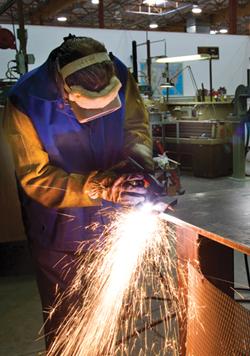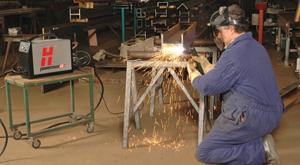- FMA
- The Fabricator
- FABTECH
- Canadian Metalworking
Categories
- Additive Manufacturing
- Aluminum Welding
- Arc Welding
- Assembly and Joining
- Automation and Robotics
- Bending and Forming
- Consumables
- Cutting and Weld Prep
- Electric Vehicles
- En Español
- Finishing
- Hydroforming
- Laser Cutting
- Laser Welding
- Machining
- Manufacturing Software
- Materials Handling
- Metals/Materials
- Oxyfuel Cutting
- Plasma Cutting
- Power Tools
- Punching and Other Holemaking
- Roll Forming
- Safety
- Sawing
- Shearing
- Shop Management
- Testing and Measuring
- Tube and Pipe Fabrication
- Tube and Pipe Production
- Waterjet Cutting
Industry Directory
Webcasts
Podcasts
FAB 40
Advertise
Subscribe
Account Login
Search
Successful plasma cutting counts on consumables
Understanding 5 critical plasma torch consumable components
- By Amanda Carlson
- July 9, 2010
- Article
- Cutting and Weld Prep

: : Always try and change out the electrode and nozzle at the same time. Switching them out individually compromises cut quality.
It’s no secret that plasma torch consumables play an integral role in achieving a successful cut. What may not be widely known, however, is the relationship among the consumable components, and that even one faulty component can cause the others to suffer.
Clayton Gould, product marketing manager of torch consumables at Hypertherm Inc., Hanover, N.H., discusses the role of the torch consumables in a hand-held plasma cutting setup, outlines what signs to look for when a component is failing, and gives advice on how to maintain your torch properly to ensure consumables work the way they should.
What are the main consumable components in a plasma torch, and how does each contribute to a successful cut?
For most manual plasma cutting systems, five different components comprise the torch consumables—the shield, retaining cap, nozzle, electrode, and swirl ring.
The shield protects the rest of the consumables. With the plasma cutting process you tend to get an awful lot of sparks and molten metal. The shield’s purpose is to prevent that from reaching the inner consumables. In some cases, the shield is a drag shield, which means it allows the operator to put the torch right on the metal without the need of an additional standoff. That’s nice, especially for inexperienced cutters.
The next is the retaining cap. The retaining cap’s duty is basically to cover and hold the consumable stackup together.
The nozzle does one of two things. First, it focuses the plasma arc. The larger the orifice, the less defined or wider the arc is. Nozzles with a wide orifice are used in gouging applications, while some have very small orifices that constrict and focus the arc. These are used for fine-feature, detailed cutting. Second, the nozzle helps to funnel gas flow, which also helps to shape and constrict the arc.
The electrode carries the current from the torch to the plate. It’s a slender piece made of copper or silver and contains hafnium or tungsten. These materials have been found to be excellent conductors of electricity. The electricity comes from the machine out to the torch and goes into a cathode block, which the electrode is in contact with, and then focuses that charge on the end of the electrode through the hafnium/tungsten insert which then arcs to the plate. The nozzle takes that arc and really focuses it in a way that cuts metal, but the electrode carries the current.
The nozzle tends to get very hot because it’s right in the midst of the superheated gas. So the back of the electrode has a cooling device attached that helps transfer the heat out of the electrode.
And last, the swirl ring channels the gas in a couple of different directions as it comes from the machine and down the torch. First, the gas goes forward in a spiral manner around the electrode, around the arc, down through the nozzle, and out through the torch. The reason the ring needs to swirl is that it allows the gas, as it’s going out through the nozzle, to be at different temperatures. The cooler gas travels along the outside—this gas is in contact with the nozzle and prevents it from burning up. If you don’t have the swirl in there, gas mixing is inadequate and you could burn up your nozzle. The other purpose of the swirl ring is to channel the gas backward and pull the heat off the electrode.

: : Remember to match plasma consumables with the application. Failing to do so will only shorten the life of the consumables and in some cases compromise desired cut quality.
What are the visual signs that one of the five consumables is worn down or functioning improperly?
You will see a number of things. Remember when I mentioned that the nozzle constricts the arc at the orifice? As that nozzle is used, the orifice gets larger and out-of-round. Even though it is cooled by the gas swirling down through it, it’s still very hot. Eventually the orifice widens and you lose that constricted arc. The kerf, which is the width of metal that you remove during the cut, gets wider and wider. In addition, your cut speed gets slower because you don’t have that concentrated arc. As a result, you don’t have as much heat concentrated it one place; it sort of fans out.
A lot of this is caused by a worn nozzle. If you look at the end of the nozzle and see that the orifice is exceptionally big or oval-shaped, then you know it’s time to change the nozzle.
As you use the electrode, the hafnium/tungsten becomes molten and pieces of it start to blow out through the nozzle as you cut. It develops a pit at the front of the electrode. Once that pit depth is over 1⁄32, it’s time to change the consumable. If you don’t change out the electrode and instead run it to failure mode, which means it really won’t cut anymore, you’re actually burning through the copper now because the hafnium is gone. The arc looks like an ugly, green glow, if you can even cut at all. The whole top of the electrode will be burned off. You never want to get to that point because it introduces a tremendous amount of heat into that torch, which can cause a lot of damage.
We always recommend that you change the electrode and nozzle together. That way when you throw in a new set of consumables, you have the perfect orifice and the perfect pit depth every time. If you tend to just swap them out individually, you can compromise cut quality. You can put in a new electrode, but if your nozzle orifice is wider than it should be, you’ve given up some of the performance.
Nothing really deteriorates in the swirl ring, although it can crack as a result of being dropped or from the heating and cooling over time. Once it’s cracked, it can’t channel the gas the way it should, so it’s time to change it out. For every five to 10 sets of electrodes/nozzles, you should change the swirl ring.
With the retaining cap, look for cracks that would come from drops. Slag built up on the end of the shield can constrict the airflow coming off the shield. Make sure you avoid excessive buildup there.
What regular maintenance practices should an operator perform to ensure torch consumables are up to par?
It’s very important to replace consumables routinely, especially as you see that pit depth increase, the orifice widen, or slag build up on the shield. Besides replacing the consumables, you need to perform regular maintenance on the torch, such as replacing the torch leads when necessary. You should change the torch as needed as well. There’s no set time in which to do that, but when you start to see things like cracks in the torch’s body shell, or a cut into the torch lead’s jacket that exposes wires, you need to address them immediately.
There’s not a tremendous amount on a hand-held system to replace, but we do encounter damage resulting from water or oil in the air. Frequently hand-held plasma uses shop air (from a compressor), and some dryers in air compressors are better than others. If oil or water is present in the line, it can be very detrimental to the consumables and the system. Not only do they result in poor cut quality, they also have a negative impact on consumables life.
How long do properly maintained consumables last?
That’s tough as there’s really no right answer. First, we’re talking about hand-held systems, therefore every operator is different. Inexperienced operators may cut slowly, essentially burning through the consumables because they are introducing so much heat into the system. Also, material thickness has a tremendous amount to do with longevity. It takes a lot more energy to cut 1-in. material than it does thin-gauge material. As you cut thicker material, you have to increase your amperage. The more power or amperage you use, the shorter your consumable life will be.
In a hand-held system the consumables are air-cooled. If your torch lead leaks, is kinked, or whatever the case may be, then you’re not getting proper airflow to the torch. That means it’s running hotter than it should, and you’re getting shorter consumable life.
The core message is if you maintain your system, meaning you make sure your leads are in good condition, that you’re installing good consumables into the system, and you’re making sure the air feeding into the machine is free of water and oil, you will maximize your consumables’ life.Tips to Remember
- Be sure to match the consumables to the application. Never use low-amperage consumables for high-amperage cutting, or vice versa.
- When using unshielded consumables, always keep the torch at the proper distance from the workpiece when performing a cut.
- Remember to cut at the appropriate speed. Cutting too fast will result in an incomplete cut. Cutting too slow will put unnecessary strain on the consumables, causing them to burn out quickly.
About the Author

Amanda Carlson
2135 Point Blvd
Elgin, IL 60123
815-227-8260
Amanda Carlson was named as the editor for The WELDER in January 2017. She is responsible for coordinating and writing or editing all of the magazine’s editorial content. Before joining The WELDER, Amanda was a news editor for two years, coordinating and editing all product and industry news items for several publications and thefabricator.com.
About the Publication
Related Companies
subscribe now

The Welder, formerly known as Practical Welding Today, is a showcase of the real people who make the products we use and work with every day. This magazine has served the welding community in North America well for more than 20 years.
start your free subscription- Stay connected from anywhere

Easily access valuable industry resources now with full access to the digital edition of The Fabricator.

Easily access valuable industry resources now with full access to the digital edition of The Welder.

Easily access valuable industry resources now with full access to the digital edition of The Tube and Pipe Journal.
- Podcasting
- Podcast:
- The Fabricator Podcast
- Published:
- 04/16/2024
- Running Time:
- 63:29
In this episode of The Fabricator Podcast, Caleb Chamberlain, co-founder and CEO of OSH Cut, discusses his company’s...
- Trending Articles
Sheffield Forgemasters makes global leap in welding technology

Welding student from Utah to represent the U.S. at WorldSkills 2024

Lincoln Electric announces executive appointments

Lincoln Electric acquires RedViking

Engine-driven welding machines include integrated air compressors

- Industry Events
16th Annual Safety Conference
- April 30 - May 1, 2024
- Elgin,
Pipe and Tube Conference
- May 21 - 22, 2024
- Omaha, NE
World-Class Roll Forming Workshop
- June 5 - 6, 2024
- Louisville, KY
Advanced Laser Application Workshop
- June 25 - 27, 2024
- Novi, MI



























